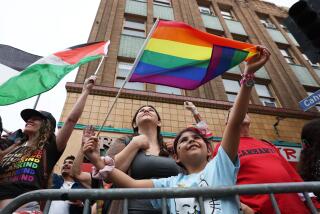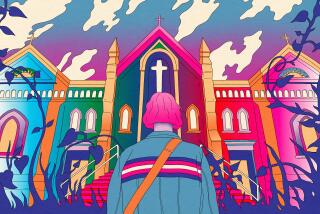Gays Are Marching in the Mainstream : Rights: Even the Army will see that narrow stereotypes don’t justify discrimination.
- Share via
Prevailing psychological opinion states that sexual attraction to one’s own gender, while varying in degree, is a permanent state of being and is irreversible. Being lesbian or gay is not an abnormality, as the American Psychological Assn. affirmed in 1973, the year homosexuality was removed from its list of mental disorders.
Many people vehemently disagree, because the discussion cuts right to the core of beliefs that are ingrained by centuries of moral doctrine misinterpreted from the Bible. People have been taught--with reinforcement by the male/female stereotype of media images--that homosexuals are defined by a nasty behavior, that their attraction has nothing to do with love, permanence, respect or any other values that ideally mark heterosexual attraction.
As a result of these teachings, passed on from generation to generation, gays and lesbians are viewed in the most narrow focus and subjected to ruthless, violent hatred. It is safer to believe interpretations of the Bible than it is to believe the complexities of psychology, and, of course, it’s easier to retain negative images reinforced by movies, TV and advertising.
Even in benign terms, gays are often compartmentalized as people who define culture--design clothes, create music, paint pictures, make movies, interpret dance. Again, it’s easier to believe that than to acknowledge that gay and lesbian people drive trucks, sell products, grow food, manage grocery stores, work on assembly lines, pave roads, fly airplanes, practice medicine, enforce the law, and, yes, even fight for their country.
Although gay and lesbian people are in every demographic category--race, ethnicity, religion, income, education level--society considers them to be a group, by definition a minority. Yet gay and lesbian people have not rated minority status, nor minority protection, nor the legitimacy conferred by public consciousness.
The beginning of this decade has seen remarkable change in how heterosexuals are treating their gay and lesbian brothers and sisters. Just this week, a federal appellate court rejected the armed forces’ blanket policy of excluding gays and lesbians; the Christopher Commission in Los Angeles has substantiated the brutal anti-gay bias of the Los Angeles Police Department and has recommended reform, and the California gay and lesbian civil-rights bill has so far survived the rhetorical garbage of twisted zealots.
Yet substantial change will not happen until public consciousness gets hip to the fact that the gay and lesbian community is massive in scope, right and left, exciting and dull, zany and reserved. In a gay pride parade you will see women dressed in leather, bearded men wearing evening gowns, camping it up for fun, boys and girls who are “nelly” or “butch” because they want to be, stereotype or not. What you won’t see are the gay men in their sober business suits and lesbians dressed like Margaret Thatcher, grimacing in embarrassment at how some of their brothers and sisters prefer to express themselves. And there are millions of gay people in between. These are all vital segments of homosexual America--the one minority still fighting for protection of its rights.
Change has begun. However, all of us, including average, everyday queers like me, are also fighting for our very lives, simply because we are different from the majority.


